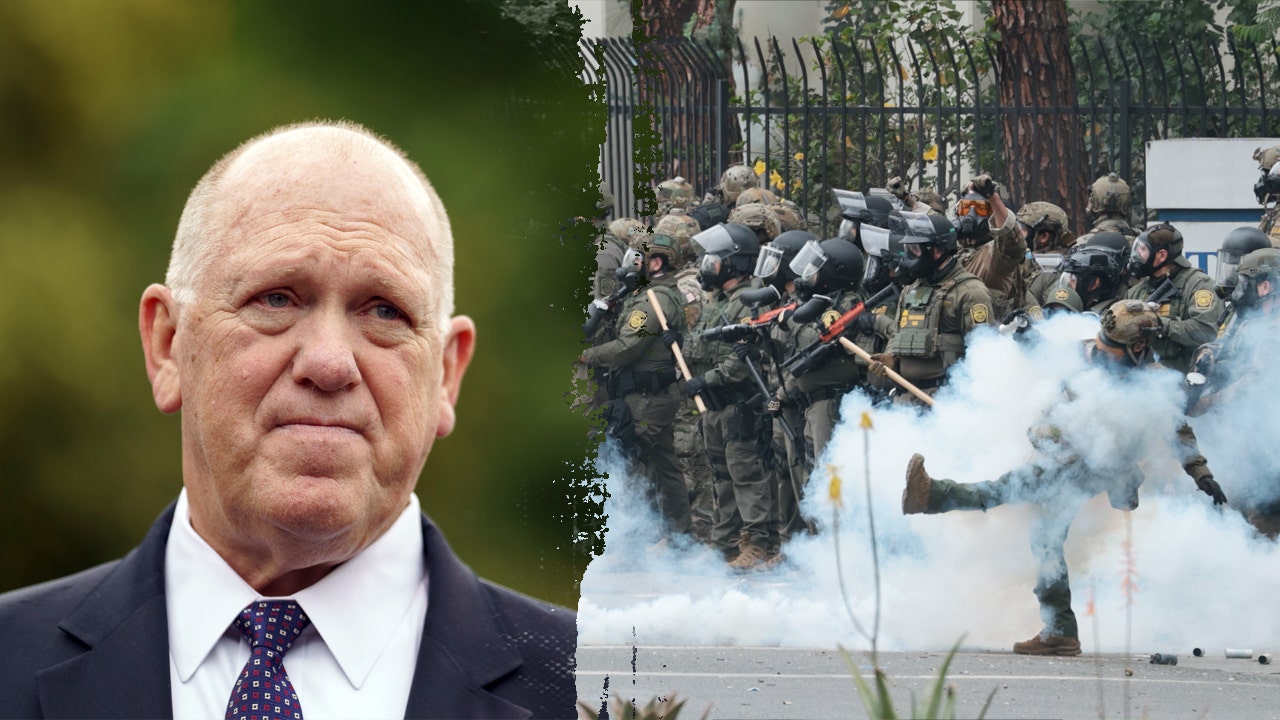Business
Opinion: Is one $6-billion settlement enough of a reckoning for the family that brought us the opiod crisis?

On Monday, the Supreme Court heard arguments in the complex bankruptcy case of Purdue Pharma, whose owners, the Sackler family, have become synonymous with the carnage wreaked on American families by the profligate and dishonest marketing and distribution of OxyContin and other opioids.
In exchange for giving up ownership of Purdue and paying up to $6 billion over the next 18 years that would be used to address the crisis they helped cause, the Sacklers, understandably but shamelessly, want to be shielded against any other civil lawsuits from victims who are not parties to the current litigation. Most of the victims who are part of the settlement — state governments, Native American tribes and individuals — agreed to the terms.
Opinion Columnist
Robin Abcarian
But should it be legal to grant the Sacklers protection from future lawsuits?
The U.S. Trustee Program, an arm of the Justice Department that oversees the administration of bankruptcy cases, argues that it is not.
Why should the Sacklers, who personally have not declared bankruptcy, be entitled to the protections that bankruptcy offers? And why should potential victims who are not part of the mega-settlement be prohibited from filing lawsuits in the future?
One argument in the Sacklers’ favor: Failing to immunize the family will tank the settlement, dismantling years of complex negotiations and depriving victims and their families of agreed upon and timely compensation. (Which, by the way, is not particularly handsome, ranging from about $3,500 to $48,000, the highest sums to be paid out over 10 years.)
The U.S. trustee argues that individual victims going forward might be able to negotiate a better deal.
“Forget a better deal. There is no other deal,” said Washington lawyer Pratik Shah, who represents a number of plaintiffs in the case, including states, tribes, hospitals and individuals.
During oral arguments, the Supremes seemed torn but leaning toward approving the settlement.
Whatever the court decides, this case should bury once and for all the lie that drug misuse and addiction stem only from bad personal choices.
The American people were victimized by a family of heedless billionaires who lied and cheated to get their product, up to twice as powerful as morphine, into our bloodstreams for profit.
It’s important to remember how the opioid crisis began. Then you can decide whether the branch of the Sackler family responsible for most of it deserves to be protected from further potential punishment.
In 1995, the Food and Drug Administration approved OxyContin, a time-release version of the painkiller oxycodone. Incredibly, the agency allowed Purdue to claim that because it was a long-acting drug, it was safer and less likely to be abused than rival painkillers such as Percocet and Vicodin. Was this claim based on findings from clinical trials? Nope. It was based on the nonsensical theory that drug abusers would prefer the quicker-hit high of fast-acting narcotics.
“If you look at the prescribing trends for all the different opioids, it’s in 1996 that prescribing really takes off,” Andrew Kolodny, co-director of the Opioid Policy Research Collaborative, at Brandeis University, told the New Yorker in 2017. “It’s not a coincidence. That was the year Purdue launched a multifaceted campaign that misinformed the medical community about the risks.”
In a 2007 plea deal with the government, Purdue admitted that it trained its sales representatives to tell doctors that Oxy was less addictive and less prone to abuse than its competitors, which we now know to be lies.
Internal documents that came to light in the Justice Department’s investigation showed that the company knew as early as 1999 that OxyContin users were exchanging tips on how to crush and snort the pills for a faster high, and that some doctors were being charged with selling prescriptions.
One familiar plot point here for anyone who has read the many excellent books about Purdue and the opioid crisis or watched their screen adaptations (including the critically acclaimed Hulu mini-series “Dopesick” and the current Netflix series “Painkiller”) revolves around Curtis Wright, the FDA examiner who approved Purdue’s package insert asserting the drug’s safety. Wright claimed he was approached by Purdue for a job after leaving the FDA. But in 2015, Richard Sackler, former president and chairman of Purdue Pharma, testified that Wright asked the company to hire him before he left the FDA. For appearance’s sake, Purdue thought it best to wait a couple of years before bringing Wright on at more than double his government salary.
In November, during an interview with a local New Hampshire TV station where he lives, Wright said, “It is a difficult, terrible situation, and I am so sorry for the people who are hurt and for the patients who can’t get good pain relief now.”
So why, exactly, can’t those people get good pain relief anymore?
After Purdue and other drug manufacturers flooded the country with opioids in the 2000s, sparking a dramatic rise in overdose deaths (and oh by the way, turning the Sacklers into multibillionaires), alarmed states passed laws limiting the prescribing and dispensing of the pain pills.
And with doctors dramatically reducing the opioid prescriptions they wrote, addicted users turned to street drugs such as heroin and, when heroin became scarce, to the much more dangerous fentanyl, which is manufactured illegally in Mexico with precursor materials from China and India, then smuggled into the U.S., generally through official ports of entry.
It’s fair to say that in recent years, the American street drug supply has essentially been poisoned by OxyContin’s illicit grandchild, fentanyl. In 1999, the Centers for Disease Control and Prevention says, 3,442 Americans died of opioid-involved overdose deaths. In 2021, the number had soared to 80,411. More than 70,000 involved synthetic opioids, mostly fentanyl.
And so, what about Purdue and the Sacklers?
Purdue is to become a public trust, overseen by an independent board that would steer the company’s profits to addressing the crisis it helped cause.
If the Supreme Court approves the bankruptcy plan, the Sacklers will be out the $6 billion they’ve agreed to, but by any standards, they will remain fabulously rich. Their infamous name will be erased from dozens of cultural and medical institutions in the U.S. and the U.K., a good thing.
But not one of them will serve a single day in prison or otherwise be much discomfited for the death and social destruction they have wreaked on this country.

Business
Sharing an inherited house with your siblings? It can get complicated

Dear Liz: My husband’s parents, who are 88 and 93, respectively, have decided to leave their house, worth $800,000, equally, to their three children, who are all in their sixties. The children get along well and all decisions will be made as a group. None of the adult children can afford to buy out the other two, and the three adults and their families cannot all live in the house at once. Everyone would like to keep the home, which is paid for, in the family. What solutions exist for this situation? Where do we begin, and what questions do we need to ask, thinking into the next generation?
Answer: Owning real estate with other people can be difficult, even when the individuals get along. Perhaps your generation can pull it off, but there’s no guarantee the next one will.
Let’s say the time has come to replace the roof. How will the group decide how much to spend, and will everyone be equally willing to split that considerable cost? How might the dynamics change if one family is living in the home, but the others are expected to pay for repairs and maintenance? What happens if one inheritor later wants to sell, and the others still can’t buy out that share?
Keeping the family home can feel like an important legacy to offer to your children, but not if ownership creates strife that imperils family relationships. An experienced estate planning attorney can meet with you as a group and discuss the scenarios and legal documents you may need going forward.
Dear Liz: When you’re writing about required minimum distributions from retirement accounts, please make sure people know about qualified charitable distributions. Those of us lucky enough not to need the money can donate it directly from an IRA to the nonprofits of our choice. That way, we don’t even have it in our income column, and there are no taxes. I am looking forward to making many qualified charitable distributions to my favorite nonprofits when I turn 73.
Answer: You don’t have to wait. Qualified charitable distributions from IRAs can start as early as age 70½. The distribution limit for 2025 is $108,000 per individual. If you’re considering this option, please familiarize with the IRS rules for such distributions and consider consulting a tax pro.
Dear Liz: I know you work to maximize people’s money. I had a thought about the quality of life with Social Security. I took it at 65, which was then full retirement age. I was fully employed and did not need it to live. However, the extra money allowed us the opportunity to travel to all seven continents, help our kids with debts and down payments, and generally enjoy things with the extra cash. Now the full retirement age is 67, so there are fewer years between full retirement age and when benefits max out at 70. But the difference could still be enough for that motor home or world cruise.
Answer: All financial planning requires a balance between current and future spending. If you spend too much in the early years, you may not have enough to make it through the later ones. Retirement planning is further complicated by the fact that we don’t know how long we’ll live or how our health will hold up. We can delay spending so long that we’re no longer able to do the things we want to do, such as travel.
Still, the fact remains that when one spouse dies, one Social Security check goes away. That can lead to a devastating drop in income for the survivor. Because the survivor receives the larger of the two benefits, and may have to live on that amount for years, it almost always makes sense for the higher earner to delay filing as long as possible.
Liz Weston, Certified Financial Planner, is a personal finance columnist. Questions may be sent to her at 3940 Laurel Canyon, No. 238, Studio City, CA 91604, or by using the “Contact” form at asklizweston.com.
Business
Los Angeles County fire victims sue AAA and USAA, alleging insurance fraud

Los Angeles County fire victims have filed lawsuits against three large home insurers alleging they were systematically underinsured, leaving them without enough money to replace or rebuild their homes after the Jan. 7 blazes.
The twin lawsuits, filed Wednesday in Los Angeles County Superior Court, allege that USAA, a Texas-based insurer that serves the military community, and two insurers affiliated with AAA for years underestimated the replacement cost of the homes, lulling the policyholders into buying inadequate coverage.
“These families paid their premiums, trusted their insurers, and did everything right,” attorney Gregory L. Bentley said in a statement. “But when disaster struck, they learned their coverage was little more than an illusion. These companies promised peace of mind, but instead left their members stranded, homeless, and hopeless.”
The lawsuits allege fraud, negligence, breach of contract and other causes of action, and seek damages and reform of the insurers’ practices.
Bekah Nelson, lead communications director for USAA, said that the company was reviewing the lawsuit and could not comment on specifics, but said “USAA’s dedication to outstanding member service is widely recognized.”
“When wildfires struck Southern California, our teams were on the ground within days, working to support our members in their time of need. To date, we have paid nearly $1.4 billion to help members recover from their losses,” she said, adding the company has made payments on more than 90% of homeowner claims.
A spokesperson for CSAA Insurance Exchange, which primarily serves AAA members in Northern California, said it does not comment on pending litigation. A spokesperson for the Interinsurance Exchange of the Automobile Club, which serves AAA members in Southern California, also declined comment.
The lawsuits open a new front in the litigation that has been spawned by the catastrophic fires, which caused at least 29 deaths and damaged or destroyed more than 16,000 homes and businesses in Altadena, Pacific Palisades and other communities.
Several lawsuits have been filed against the California Fair Plan Assn., the state’s insurer of last resort, alleging that it is not adequately handling smoke-damage claims arising out of the fires.
More than 100 of the state’s licensed home insurers, including the CSAA, USAA and the Interinsurance Exchange, are defendants in an April lawsuit accusing the companies of colluding to drop policyholders and force them onto the FAIR Plan in order to reduce their claims exposure. The plan’s policies typically cost more and offer less coverage than traditional commercial insurance.
The lawsuits filed Wednesday, which are virtually identical except for details pertaining to the different defendants, allege that the problem of underinsurance is “pervasive” and stems from “cost estimator software many insurers use to recommend coverage limits to insureds,” as well as “poor design choices, perverse profit and commission incentives, volume business, and other shortcomings.”
The lead plaintiffs in the lawsuit filed against the two AAA insurers, James and Lisa Fulker, bought a three-bedroom, two-bathroom, 1,872-square-foot home on Kingsport Drive in Malibu in 2020, according to the lawsuit.
The newly renovated home — which featured a kitchen with a center island, quartz countertops, high ceilings, a fireplace, an entertainment patio and a master suite with a walk-in closet and spa-like bath — had $713,000 in primary dwelling coverage and 125% extended replacement cost coverage, the lawsuit states.
After the fires, however, the couple found their coverage was inadequate as they received estimates of at least $800 per square foot or more to rebuild, far exceeding the $380-per-square-foot calculations of their insurer, the lawsuit states.
The lead plaintiffs in the USAA lawsuit, Ethan and Marijana Alexander, had a 2,135-square-foot, four-bedroom, three-bathroom, near-custom home on Bienveneda Avenue in Pacific Palisades that they bought in 2018, according to the lawsuit.
The home had $584,000 in dwelling coverage and a 25% home protection endorsement of $146,000, the lawsuit states.
Even with the additional coverage, the complaint alleges the couple don’t have adequate insurance to rebuild, with USAA calculating the cost at $342 per square foot and the couple receiving estimates at more than $850 to $1,000 per square foot, the lawsuit states.
Business
Jobs at the Port of Los Angeles are down by half, executive director says

Job opportunities at the Port of Los Angeles are dwindling as President Trump’s steep tariffs take a hit on global trade and a major economic engine for the regional economy.
Nearly half of the longshoremen who support operations at the port went without work over the last two weeks, Gene Seroka, executive director of the Port of Los Angeles, said in an interview.
The port processed 25% less cargo than forecast for the month of May, he said.
Trump’s tariffs have drastically stemmed the flow of goods into the U.S., driving down activity at the neighboring ports of L.A. and Long Beach, which collectively processed more than 20 million 20-foot-long cargo units last year.
The two ports are the largest in the country and provide jobs for thousands of dockworkers, heavy equipment operators and truck drivers.
But work has fallen off sharply in recent weeks. Over the last 25 work shifts, only 733 jobs were available for 1,575 longshoremen looking for work.
“They haven’t been laid off, but they’re not working nearly as much as they did previously,” Seroka told The Times. “Since the tariffs went into place, and in May specifically, we’ve really seen the work go off on the downside.”
Marine terminal operators post available work opportunities, known as job orders, on a digital board at the port three times a day. Longshoremen can review the job orders at each shift and bid on the jobs they want to take. If there are more longshoremen than job orders, a portion of workers will go without pay.
The average of 733 job orders posted over the past 25 shifts, which is equal to roughly two weeks, is unusually low.
Ordinarily, between 1,700 and 2,000 job orders are posted during a typical day shift, and between 1,100 and 1,400 are posted during a standard night shift.
Seroka attributed the decrease in job opportunities to lower cargo volume moving through the port.
In May, 17 cargo ships canceled their planned trips to Los Angeles amid uncertainty over duties the Trump administration imposed worldwide.
Although May is typically a busier month than April, this past May saw 18% less cargo processed than the month prior, according to port data.
The falloff comes during a critical time in advance of the Christmas shopping season, orders for which are usually placed before July 1.
Conditions are not expected to significantly improve anytime soon.
“The June numbers that we’re projecting right now are nowhere near where they traditionally should be,” Seroka said.
An average of five ships have entered the port each day over the last week. This time of year, there would typically be between 10 and 12 ships in the port each day.
“The drop in cargo volume caused by Trump’s tariffs will mean empty shelves when products don’t reach our stores, rising prices on everything from groceries to clothes to cars, and undoubtedly, more Americans out of work,” U.S. Sen. Alex Padilla of California said in a news conference last month.
The decline in shipping has broader ripple effects on L.A.’s logistics economy.
A 2023 report found that the ports of Los Angeles and Long Beach contributed $21.8 billion in direct revenue to local service providers, generating $2.7 billion in state and local taxes and creating 165,462 jobs, directly and indirectly.
A decline of just 1% in cargo to the ports would wipe away 2,769 jobs and endanger as many as 4,000 others, the study found.
Union officials could not be reached for comment on Friday but had previously predicted job losses for their members.
“Some of the workforce will not be getting their full 40 hours a week based on the loss of cargo,” Gary Herrera, president of the longshoremen union ILWU Local 13, warned last month.
“That is going to have an effect on the work opportunities for not just us, but for truck drivers, warehouse workers and logistics teams,” he said.
The slowdown in activity at the ports of L.A. and Long Beach has also spread into surrounding communities. Businesses in the area rely on a robust community of port workers to frequent their establishments.
“We’re starting to hear from small businesses and restaurants in the harbor area that their customer patronage is trending downward,” Seroka said. “Outside of COVID, this is the biggest drop I’ve seen in my career.”
-

 Politics1 week ago
Politics1 week agoMichelle Obama facing backlash over claim about women's reproductive health
-

 Technology1 week ago
Technology1 week agoOpenAI wants ChatGPT to be a ‘super assistant’ for every part of your life
-

 Movie Reviews1 week ago
Movie Reviews1 week agoThe Verdict Movie Review: When manipulation meets its match
-

 Technology1 week ago
Technology1 week agoWhy do SpaceX rockets keep exploding?
-

 West2 days ago
West2 days agoBattle over Space Command HQ location heats up as lawmakers press new Air Force secretary
-

 Finance1 week ago
Finance1 week agoHere's what will boost your feeling of financial well-being the most, researchers say
-

 World1 week ago
World1 week agoTwo killed in Russian attacks on Ukraine before possible talks in Turkiye
-

 News1 week ago
News1 week agoDepartment of Homeland Security lists sanctuary jurisdictions in Northern California















